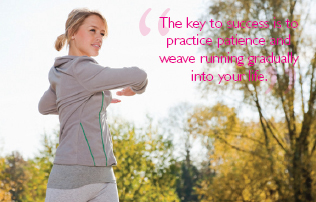
I used to hate to run. Coming from a coach who has made her career out of the sport, you might find this hard to believe—but it’s 100-percent true.
Many women, myself included at one point, believe that running is for in-shape athletes and that it involves painful, needless suffering and long, difficult workouts. It’s because of these myths that you might stay away from the sport or think that you can’t do it…but you can. All you need is a simple plan that makes running fun and eases your body gently into training.
Whether you’re looking to start a running program or want to get back into shape, my Keep it Simple (KIS) plan will help you reach your goals. You won’t find a lot of complicated formulas and track workouts. What you will find is a secret recipe that has taken me and thousands of other running wannabes from sitting on the couch to striding many happy miles down the road.
Getting Started
The secret to success is having the patience to start from where you are (not where you wish you were). If you’re where I was when I started (out of shape or overweight), start with three weeks of walking 15 to 30 minutes four to five days per week. Once you develop a base of regular walking, start with the KIS program.
If you are already active but not a runner, start this program while keeping any other activities (i.e. biking, yoga, Zumba) at an easy-to-moderate intensity. The key to success is to practice patience and weave running gradually into your life.
The Goal
The secret to happy running is to create a habit so sticky that you feel off when you don’t run. You can get to this place by finishing every workout feeling as if you could go a little farther. If you feel happy when you’re done, the likelihood of wanting to run again is very high. If you finish feeling tired and frustrated, you might toss those running shoes in the closet and give up completely. Run happy and you’ll run again and again, creating a momentum that will keep you running for life.
The Plan

Once you complete the initial assessment, you’re ready for Workout 2. Warm up with five minutes of progressively faster walking. For the next 20 minutes, repeat your personal run/walk interval as determined by the test and finish with a five-minute cool down. Repeat this workout, using the exact same intervals for the next three weeks to allow your body time to adapt and grow stronger.
After three weeks, you’ll start the processes over. Repeat the assessment to find your new interval and perform the following workouts, using this interval for the next three weeks. Continue to work your way through this cycle, completing the assessment every third week and adjusting your workouts accordingly.
When you reach the point where you can run for 20 minutes continuously, you’ll begin to add five minutes of running to your workouts. When you reach 30 minutes of running three times per week, the world is your oyster. Stick with this for two to four weeks and evaluate your next running goal. It could be finishing a 5k or continuing to increase your distance. Regardless, you now have a recipe and rate of progression that works for your body. Congratulations, you’re a runner!
KIS PLAN
Complete this progression, repeating the Personal Inventory Assessment every three weeks until you are running for 20 minutes without stopping. At this point, weave in one 25-minute run per week for three weeks. Next, add another five minutes for a total of 30 minutes. Then take a look in the mirror—you’ll see a full-fledged runner!

My Story

While I would never admit it, there was a part of me that longed to run. My childhood softball coach, Rosemary Reid, ran her daily three-mile run by our house with a smile so big it could change the world. I wanted that smile, and I would occasionally put on my shoes and run as far as I could—only to reach the end of my block in tears.
I didn’t begin running in earnest until my early 20s. It was the summer of 1990, and I had just started an internship for a corporate fitness facility. Ironically,
I was painfully out of shape and overweight. All the other fitness center employees were runners. Despite my self-doubts, they convinced me to try running. They created a plan for me and trained with me during lunch. The target was a 5k with the corporate team in four months.
They had me start by walking. Fifteen minutes of walking soon turned to a half-hour, and then we began to sprinkle in seconds of running here and there. I finished most workouts feeling as if I could go a little farther. As more minutes of running replaced walking, I developed a newfound confidence. I was still slow, but I was doing it.
By the end of the season, I was able to build up to running 30 minutes. I toed the line of the 5k consumed with worry, but as soon as I started running, my fear evaporated with each stride. As it turned out, nobody cared that I was slow or that I wasn’t wearing the “proper” clothes. Everyone was moving forward with a sense of purpose and community.
Crossing the finish line changed my life. I learned I could achieve anything I put my mind to. It didn’t matter that I finished nearly last or that I was beaten by a 72-year-old man. For me, finishing was winning.
I tell you this story not to impress you but to impress upon you that you too have a runner inside.
[Source: Women’s Running Magazine – WomensRunning.com ]


